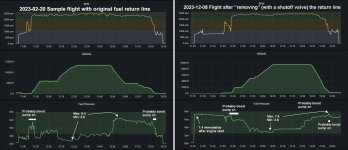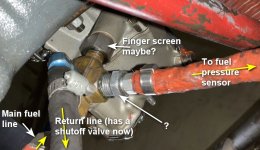I recently removed a fuel return line on my RV-6A (carbureted). See https://vansairforce.net/threads/what-is-this-mystery-fuel-return-line-for.221249/. It accomplished the intended purpose of raising fuel pressures from the dangerously low level I had. Before, the pressures were 1-3 psi in flight (sometimes as low as 0.1 psi, triggering an alarm). After the design change, the pressure is 5-8 psi, and averages 6.8 psi in cruise. It still fluctuates, but at least it's at a safe pressure to keep the engine running.
However, now I have a carburetor leaking fuel. I already sent the carburetor in to Tempest Aero in NC. They normally test these to 6 psi, and at that pressure they could not replicate the problem. At 10 psi, they saw leaking from the float valve. They replaced the valve, and the carb is in-transit back to me now. But they were curious what engine-drivel fuel pump or fuel system plumbing I have that could be causing these unusually "high fuel pressures". They recommended I do not allow fuel pressures to go above 10 psi; otherwise the float valve could be lifted off the seat.
As far as I know, my removing that mystery line was just returning the fuel system to the stock Van's design. But their comment makes me wonder...
So, two questions, for anyone with a carbureted Lycoming O-320, with EIS data available:

However, now I have a carburetor leaking fuel. I already sent the carburetor in to Tempest Aero in NC. They normally test these to 6 psi, and at that pressure they could not replicate the problem. At 10 psi, they saw leaking from the float valve. They replaced the valve, and the carb is in-transit back to me now. But they were curious what engine-drivel fuel pump or fuel system plumbing I have that could be causing these unusually "high fuel pressures". They recommended I do not allow fuel pressures to go above 10 psi; otherwise the float valve could be lifted off the seat.
As far as I know, my removing that mystery line was just returning the fuel system to the stock Van's design. But their comment makes me wonder...
So, two questions, for anyone with a carbureted Lycoming O-320, with EIS data available:
- What is the typical fuel pressure you see in flight, and what is the highest fuel pressure you've ever seen?
- Is it normal for fuel pressure to fluctuate at all, in flight?
- Do you have any sort of pressure-relief valve in your fuel system that would prevent pressures from going higher than 10 psi?
- Engine: Lycoming O-320-E2A
- Carburetor: Marvel Schebler MA-4SPA (P/N 10-3678-32)
- Engine-driven pump: AC 41271 (equivalent part number to an LW-15472); from what I understand, the "low pressure" pumps for use with a carburetor are rated for 4-6 psi.
- Electric boost pump: Facet 40108; not sold anymore; Van's Aircraft says it provides 6 psi; I've seen 6-7 psi on the ground with engine off.
- Fuel pressure sensor: Grand Rapids LPS-02, connected to a Grand Rapids EIS4000 and displayed on EFIS
Last edited:






